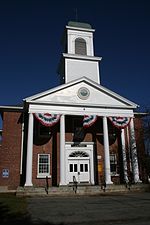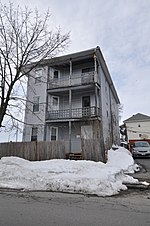Washburn Square–Leicester Common Historic District

The Washburn Square–Leicester Common Historic District encompasses the historic civic heart of Leicester, Massachusetts. It includes Washburn Square, as the town common is called; the buildings along its perimeter; and the properties along Main Street extending east along Main Street to its junction with Henshaw Street. It includes the 1939 Leicester Town Hall, Becker College's 1962 Swan Library, a Victorian Gothic Revival First Congregational Church (a rarity due to its comparatively late construction date, 1901) and the 1834 Leicester Unitarian Church (originally known as the Second Congregational Church). The south side of Washburn Square (named for Leicester native son Governor Emory Washburn) is lined with stately homes that now are almost all owned by Becker College.The district was listed on the National Register of Historic Places in 2006.
Excerpt from the Wikipedia article Washburn Square–Leicester Common Historic District (License: CC BY-SA 3.0, Authors, Images).Washburn Square–Leicester Common Historic District
Main Street,
Geographical coordinates (GPS) Address Nearby Places Show on map
Geographical coordinates (GPS)
| Latitude | Longitude |
|---|---|
| N 42.246111111111 ° | E -71.903611111111 ° |
Address
Main Street 963
01524
Massachusetts, United States
Open on Google Maps








